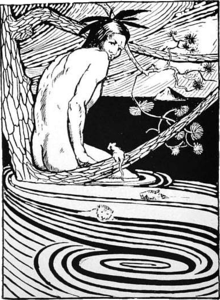- Nanabozho
-
In Anishinaabe mythology, particularly among the Ojibwa, Nanabozho is a spirit, and figures prominently in their storytelling, including the story of the world's creation. Nanabozho is the Ojibwe trickster figure and culture hero (these two archetypes are often combined into a single figure in First Nations mythologies). He plays a similar role as the Saulteaux Wiisagejaak (Cree Wisakedjak). The Algonquin had a similar figure called Ganoozhigaabe (Abenaki Gluskabe).
Among the eastern Algonquian peoples located north of the Abenaki areas, a similar character to Nanabozho existed, called Tshakapesh in the Innu language, Tcikapec in Attikamek, Tcakabesh in Algonquin, Chikapash among the eastern James Bay Crees and Chaakaapaas by the Naskapi, changing to various animal forms to various human forms (adult to child) and to various mythical animals such as the Great Porcupine, or Big Skunk. He conquered or diminished these mythical animals to smaller size after killing or changing them with his trickery or shape shifting.
Nanabozho was one of four sons of Wiininwaa ("Nourishment"),[1] a human mother, and E-bangishimog ("In the West"), a spirit father.
Nanabozho most often appears in the shape of a rabbit and is characterized as a trickster. In his rabbit form, he is called Mishaabooz ("Great rabbit" or "Hare") or Chi-waabooz ("Big rabbit"). He was sent to Earth by Gitchi Manitou to teach the Ojibwe. One of his first tasks was to name all the plants and animals. Nanabozho is considered to be the founder of Midewiwin. Like the Egyptian god Thoth, he is thought to be the inventor of fishing and hieroglyphs. This deity is a shape-shifter and a cocreator of the world.[2][3]
In more recent myths among the Ojibwe, Nanabozho saves the forests from Paul Bunyan. They fought for forty days and nights, and Nanabozho killed Bunyan with a Red Lake walleye.
Contents
Nanabozho name variations
The Nanabozho name varies in the Anishinaabe language depending on whether it is presented with a n1 (first-person) prefix n- (i.e. Nanabozho), n3 (third-person) prefix w- (i.e. Wanabozho) or nX (null-person) prefix m- (i.e. Manabozho); the "Manabozho" form of the name is most commonly associated with Menomini-version of these stories. In addition, depending on the story and the narrator's role in telling the story, the name may be presented in its regular nominative form (with the final "o", i.e. Nanabozho) or in its vocative form (without the final "o", i.e. Nanabozh). Due to the way the two "o" sounds, they are often each realized as "oo" (i.e. Nanaboozhoo). In some dialects, "zh" is reduced to "z." These variations allow for associating the name with the word for "rabbit(-)" (waabooz(o-)).
Due to the placement of word stress, determined by metrical rules that define a characteristic iambic metrical Foot, in which a Weak syllable is followed by a Strong syllable, in some dialects the weak syllable may be reduced to a schwa, which may be recorded either as "i" or "e" (e.g. Winabozho or Wenabozho if the first weak syllable is graphically shown, Nanabizho if the second weak syllable is graphically shown).
In addition, though the Fiero double-vowel system uses "zh", the same sound in other orthographies can be realized as "j" in the Algonquin system or "š" (or "sh") in the Saulteaux-Cree system (e.g. Nanabozho v. Nanabojo). To this mix, depending on if the transcriber used French or English, the Anishinaabe name may be transcribed to fit the phonetic patterns of one of the two said languages (e.g. "Winnaboujou" and "Nanabijou": French rendering of Winabozho and Nanabizho respectively, or "Nanabush": English rendering of Nanabozh).
Mishaabooz name variations
Like the transcription variations found among "Nanabozho," often Mishaabooz is transcribed into French as Michabous and represented in English as Michabou.
Naniboujou Club Lodge
The spirit Naniboujou also provided the namesake for the Historical Naniboujou Club Lodge, built in the late twenties, due to his suggested role in the creation of nature.[4]
Note
- ^ The Anishinaabeg say the mother's name means "nourishment", but Schoolcraft suggests the name is from the Dakota Winona ("first-born daughter").
- ^ "The Great Hare". Community-2.webtv.net. http://community-2.webtv.net/TheObsidianMask/GreatHare/index.html. Retrieved 2010-06-29.
- ^ "Nanabozho, Access geneaology". Accessgenealogy.com. http://www.accessgenealogy.com/native/tribes/history/nanabozho.htm. Retrieved 2010-06-29.
- ^ Naniboujou Club Lodge History
See also
- Aayaase
- Glooscap
- Naniboujou Club Lodge
- Sleeping Giant (Ontario)
- Winneboujou, Wisconsin
- Wisakedjak
- Maymaygwashi
References
- Benton-Banai, Edward. The Mishomis Book: The Voice of the Ojibway. Hayward, WI: Indian Country Communications, 1988.
- Chamberlain, A. F. "Nanibozhu amongst the Otchipwe, Mississagas, and other Algonkian tribes," Journal of American Folklore 4 (1891): 193-213.
- Johnston, Basil. Ojibway Heritage. Toronto: McClelland and Stewart, 1976.
- Barnouw, Victor. Wisconsin Chippewa Myths and Tales. Madison: University of Wisconsin Press, 1977.
External links
- "Manabosho's Hieroglyphics" recorded by Seth Eastman at Northern Illinois University
- "Nanabozo" in The Canadian Encyclopedia
- "Nanabozho" in Handbook of American Indians North of Mexico, 1907. Reproduced in Handbook of Indians of Canada, 1913.
- How Nanabush Created the World
- Nanabush and the Giant Beaver
- The Legend of 'Nanabozho' (from the CBC radio archives, as an audio file)
- Nanabozho (his entry at www.godchecker.com)
- Native American: North Gods: Algonquin
- Nanabozho, Access geneaology.
Categories:- Anishinaabe mythology
- Trickster gods
- Magic gods
- Creator gods
- Algonquian personal names
Wikimedia Foundation. 2010.


